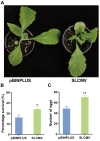Transcriptional Modulation of Plant Defense Genes by a Bipartite Begomovirus Promotes the Performance of Its Whitefly Vector
- PMID: 39599769
- PMCID: PMC11598951
- DOI: 10.3390/v16111654
Transcriptional Modulation of Plant Defense Genes by a Bipartite Begomovirus Promotes the Performance of Its Whitefly Vector
Abstract
The majority of plant viruses rely on insect vectors for inter-plant transmission. Amid virus transmission, vector-borne viruses such as begomoviruses may significantly modulate host plants in various ways and, in turn, plant palatability to insect vectors. While many case studies on monopartite begomoviruses are available, bipartite begomoviruses are understudied. More importantly, detailed elucidation of the molecular mechanisms involved is limited. Here, we report the mechanisms by which an emerging bipartite begomovirus, the Sri Lankan cassava mosaic virus (SLCMV), modulates plant defenses against whitefly. SLCMV infection of tobacco (Nicotiana tabacum) plants significantly downregulated defenses against whitefly, as whitefly survival and fecundity increased significantly on virus-infected plants when compared to the controls. We then profiled SLCMV-induced transcriptomic changes in plants and identified a repertoire of differentially expressed genes (DEGs). GO enrichment analysis of DEGs demonstrated that the term defense response was significantly enriched. Functional analysis of DEGs associated with defense response revealed that four downregulated DEGs, including putative late blight resistance protein homolog R1B-17 (R1B-17), polygalacturonase inhibitor-like (PGI), serine/threonine protein kinase CDL1-like (CDL1), and Systemin B, directly contributed to plant defenses against whitefly. Taken together, our findings elucidate the role of novel plant factors involved in the modulation of plant defenses against whitefly by a bipartite begomovirus and shed new light on insect vector-virus-host plant tripartite interactions.
Keywords: Bemisia tabaci; Nicotiana tabacum; Sri Lankan cassava mosaic virus; insect vector–virus–plant tripartite interactions; transcriptome.
Conflict of interest statement
The authors declare no conflicts of interest.
Figures






Similar articles
-
Transcriptomic profiling reveals the complex interaction between a bipartite begomovirus and a cucurbitaceous host plant.BMC Genomics. 2024 Sep 18;25(1):876. doi: 10.1186/s12864-024-10781-6. BMC Genomics. 2024. PMID: 39294575 Free PMC article.
-
Enhanced association of whitefly-begomovirus competence with plant-mediated mutualism.Pest Manag Sci. 2025 Apr;81(4):2126-2132. doi: 10.1002/ps.8613. Epub 2024 Dec 18. Pest Manag Sci. 2025. PMID: 39691989
-
Modulation of Plant Interactions with Whitefly and Whitefly-Borne Viruses by Salicylic Acid Signaling Pathway: A Review.Viruses. 2025 Jun 7;17(6):825. doi: 10.3390/v17060825. Viruses. 2025. PMID: 40573416 Free PMC article. Review.
-
Impacts of Cucurbit Chlorotic Yellows Virus (CCYV) on Biological Characteristics of Its Vector Bemisia tabaci (Hemiptera: Aleyrodidae) MED Species.J Insect Sci. 2021 Sep 1;21(5):18. doi: 10.1093/jisesa/ieab084. J Insect Sci. 2021. PMID: 34718644 Free PMC article.
-
Immunity responses as checkpoints for efficient transmission of begomoviruses by whiteflies.Virology. 2025 Apr;605:110462. doi: 10.1016/j.virol.2025.110462. Epub 2025 Feb 21. Virology. 2025. PMID: 40020542 Review.
References
Publication types
MeSH terms
Associated data
- Actions
- Actions
Grants and funding
LinkOut - more resources
Full Text Sources

